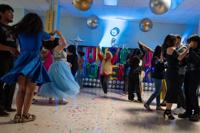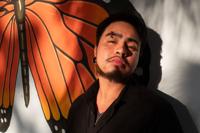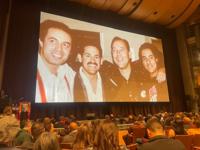
When Chico Escoto turned 15, his family celebrated his birthday with a big party. They invited dozens of friends and relatives, who enjoyed tacos, birria (stewed beef) and tres leches (three milks) cake, and danced the evening away as a DJ played popular tunes in both English and Spanish.
But for Escoto, a transgender man, it was a challenging day.
“It was before my transition … so, unfortunately, I was still viewed as a female and my family really wanted to have a quinceañera for me, but I hated it,” said Escoto, now 25, who grew up in Van Nuys. He recalled how deeply uncomfortable he felt wearing a traditional quinceañera gown at a time in his life when he was very much “still in the closet” about his true gender identity.
“I remember thinking, ‘I would rather be a chambelan,’” he added, referring to the traditionally male “court member” – comparable to a groomsman – who typically wears a suit and escorts a dama (young lady), similar to a bridesmaid on the day of the celebration.
“I hated it because I wasn’t seen for who I really was – who I really am – so it was hard for me,” he explained.
Flash forward 10 years, to a late weekday afternoon in May in the Rainbow Pride Center at Los Angeles Valley College (LAVC) – Escoto was donning his favorite botas (boots), black dress shirt and jeans as he happily danced along to the rhythms of old-school cumbias surrounded by a few close friends and dozens of new ones who enthusiastically cheered him on.

The event was the college’s first-ever “Undocuqueer Quinceañera,” which was presented by LAVC’s Mosaic Village Community Center to give queer and undocumented campus staff, faculty and current and prospective students the opportunity to belatedly enjoy the popular cultural rite of passage for the first time or the opportunity to “redo” a past quinceañera as their true gender.
That’s what Escoto was hoping to do, and that’s precisely how it felt, he said. Just like at his first quinceañera, there were delectable dishes, sweet desserts and, of course, music and dancing. But this time, he noted, he felt truly “seen” and the entire celebration was “very gender affirming.”
“It’s like [the event] was renewing the quince experience for me,” said Escoto, adding that he was happy to be recognized and participate as the person he really is. “It was my first quince where I was presented as a male, so it was a very good experience for me – very good.”
The gathering – which included a lesson and demonstration of a traditional quinceañera vals (waltz) – brought together a diverse group of young and older adults of all genders, races and ethnicities, some dressed casually and others wearing ties, jackets and even a few ball gowns.
“I loved the energy of the people and the community feeling of the event, which also seemed to [celebrate] intersectionality,” he said. “It felt amazing to me. Overall, it was a great experience.”
The atmosphere at the Undocuqueer Quinceañera felt like a “safe space” from the moment he arrived, described Escoto. That safe feeling was a far cry from his childhood when his mother reacted with shock and disdain the first time he tried to talk to her about his sexual orientation.
“I was scared to come out as trans, because when I was 9, I came out to her as bisexual, and my mom, who is a Christian and very conservative, said, ‘You have demons inside you,’” he said. “That kind of traumatized me into waiting and I didn’t say anything again for years.”
That was the very reason Escoto never told his family he didn’t want a quinceañera at all, he explained. He also felt somewhat conflicted about it, because while he didn’t want the party, at the same time he appreciated all the time, effort and expense his family put into planning it.
When Escoto finally came out as trans to his mother and other relatives a few years later, many of his family relationships became deeply strained, and he went through periods of isolation and depression.
“For most people, especially teenagers, having acceptance and being seen by your loved ones is so important,” he said, noting that he found strength from friends and through achieving a sense of personal acceptance. As he became stronger, his estranged relatives eventually returned.
“All of them have come around to see me and accept me for who I am, for who I’ve always been,” said Escoto. “And over the years, I learned to accept myself, too.
“Back when I had my quinceañera [at 15], I was physically present, but I wasn’t really myself – now I am finally seen as male and I’m fully comfortable with my gender identity,” he continued. “And getting to celebrate a quinceañera again was an important milestone for me. I loved it.”












(0) comments
Welcome to the discussion.
Log In
Keep it Clean. Please avoid obscene, vulgar, lewd, racist or sexually-oriented language.
PLEASE TURN OFF YOUR CAPS LOCK.
Don't Threaten. Threats of harming another person will not be tolerated.
Be Truthful. Don't knowingly lie about anyone or anything.
Be Nice. No racism, sexism or any sort of -ism that is degrading to another person.
Be Proactive. Use the 'Report' link on each comment to let us know of abusive posts.
Share with Us. We'd love to hear eyewitness accounts, the history behind an article.